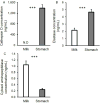Changes in Proteases, Antiproteases, and Bioactive Proteins From Mother's Breast Milk to the Premature Infant Stomach
- PMID: 28906320
- PMCID: PMC5780254
- DOI: 10.1097/MPG.0000000000001719
Changes in Proteases, Antiproteases, and Bioactive Proteins From Mother's Breast Milk to the Premature Infant Stomach
Abstract
Objective: Our previous studies suggested that human milk proteases begin to hydrolyze proteins in the mammary gland and continue within the term infant' stomach. No research has measured milk protease and pepsin activity in the gastric aspirates of preterm infants after human milk feeding. This study investigated how the concentrations of human milk proteases and protease inhibitors changed in the premature infant stomach.
Methods: Human milk and infant gastric samples were collected from 18 preterm-delivering mother-infant pairs (24-32 week gestational age). Paired human milk and gastric samples were collected across postnatal age (2-47 days). Protease concentrations were determined by spectrophotometric or fluorometric assays, and the concentrations of protease inhibitors and bioactive proteins were determined by enzyme-linked immunosorbent assay. Paired t tests were applied to compare enzymes, antiproteases, and bioactive proteins between human milk and gastric samples.
Results: Our study reveals that although human milk proteases, including carboxypeptidase B2, kallikrein, plasmin, cathepsin D, elastase, thrombin, and cytosol aminopeptidase, are present in the preterm infant stomach, only plasmin and cathepsin D can actively hydrolyze proteins at gastric pH. Enzyme-linked immunosorbent assay and peptidomic evidence suggest that all milk antiproteases as well as lactoferrin and immunoglobulin A are partially digested in the preterm stomach.
Conclusions: Most human milk proteases are active in milk but not at preterm infant gastric pH. Only cathepsin D and plasmin have potential to continue degrading milk proteins within the preterm infant stomach.
Conflict of interest statement
Author disclosures: V. Demers-Mathieu, S. D. Nielsen, M. A. Underwood, R. Borghese and D. C. Dallas have no conflicts of interest.
Figures



Similar articles
-
Analysis of Milk from Mothers Who Delivered Prematurely Reveals Few Changes in Proteases and Protease Inhibitors across Gestational Age at Birth and Infant Postnatal Age.J Nutr. 2017 Jun;147(6):1152-1159. doi: 10.3945/jn.116.244798. Epub 2017 Apr 19. J Nutr. 2017. PMID: 28424255 Free PMC article.
-
Premature Infants have Lower Gastric Digestion Capacity for Human Milk Proteins than Term Infants.J Pediatr Gastroenterol Nutr. 2018 May;66(5):816-821. doi: 10.1097/MPG.0000000000001835. J Pediatr Gastroenterol Nutr. 2018. PMID: 29135822 Free PMC article.
-
The preterm infant stomach actively degrades milk proteins with increasing breakdown across digestion time.Acta Paediatr. 2018 Jun;107(6):967-974. doi: 10.1111/apa.14244. Epub 2018 Feb 22. Acta Paediatr. 2018. PMID: 29385274 Free PMC article.
-
Gastric proteolysis in preterm infants fed mother's milk or formula.Adv Exp Med Biol. 2001;501:403-8. doi: 10.1007/978-1-4615-1371-1_50. Adv Exp Med Biol. 2001. PMID: 11787709 Review.
-
Proteolytic Systems in Milk: Perspectives on the Evolutionary Function within the Mammary Gland and the Infant.J Mammary Gland Biol Neoplasia. 2015 Dec;20(3-4):133-47. doi: 10.1007/s10911-015-9334-3. Epub 2015 Jul 16. J Mammary Gland Biol Neoplasia. 2015. PMID: 26179272 Free PMC article. Review.
Cited by
-
Neutralizing Antibodies and Cytokines in Breast Milk After Coronavirus Disease 2019 (COVID-19) mRNA Vaccination.Obstet Gynecol. 2022 Feb 1;139(2):181-191. doi: 10.1097/AOG.0000000000004661. Obstet Gynecol. 2022. PMID: 35104067 Free PMC article.
-
Survival of Immunoglobulins from Human Milk to Preterm Infant Gastric Samples at 1, 2, and 3 h Postprandial.Neonatology. 2018;114(3):242-250. doi: 10.1159/000489387. Epub 2018 Jun 25. Neonatology. 2018. PMID: 29940583 Free PMC article.
-
Comparison of Human Milk Immunoglobulin Survival during Gastric Digestion between Preterm and Term Infants.Nutrients. 2018 May 17;10(5):631. doi: 10.3390/nu10050631. Nutrients. 2018. PMID: 29772785 Free PMC article.
-
Ecologies, synergies, and biological systems shaping human milk composition-a report from "Breastmilk Ecology: Genesis of Infant Nutrition (BEGIN)" Working Group 2.Am J Clin Nutr. 2023 Apr;117 Suppl 1(Suppl 1):S28-S42. doi: 10.1016/j.ajcnut.2022.11.027. Am J Clin Nutr. 2023. PMID: 37173059 Free PMC article.
-
The Preterm Gut Microbiota: An Inconspicuous Challenge in Nutritional Neonatal Care.Front Cell Infect Microbiol. 2019 Apr 2;9:85. doi: 10.3389/fcimb.2019.00085. eCollection 2019. Front Cell Infect Microbiol. 2019. PMID: 31001489 Free PMC article. Review.
References
Publication types
MeSH terms
Substances
Grants and funding
LinkOut - more resources
Full Text Sources
Other Literature Sources
Research Materials

